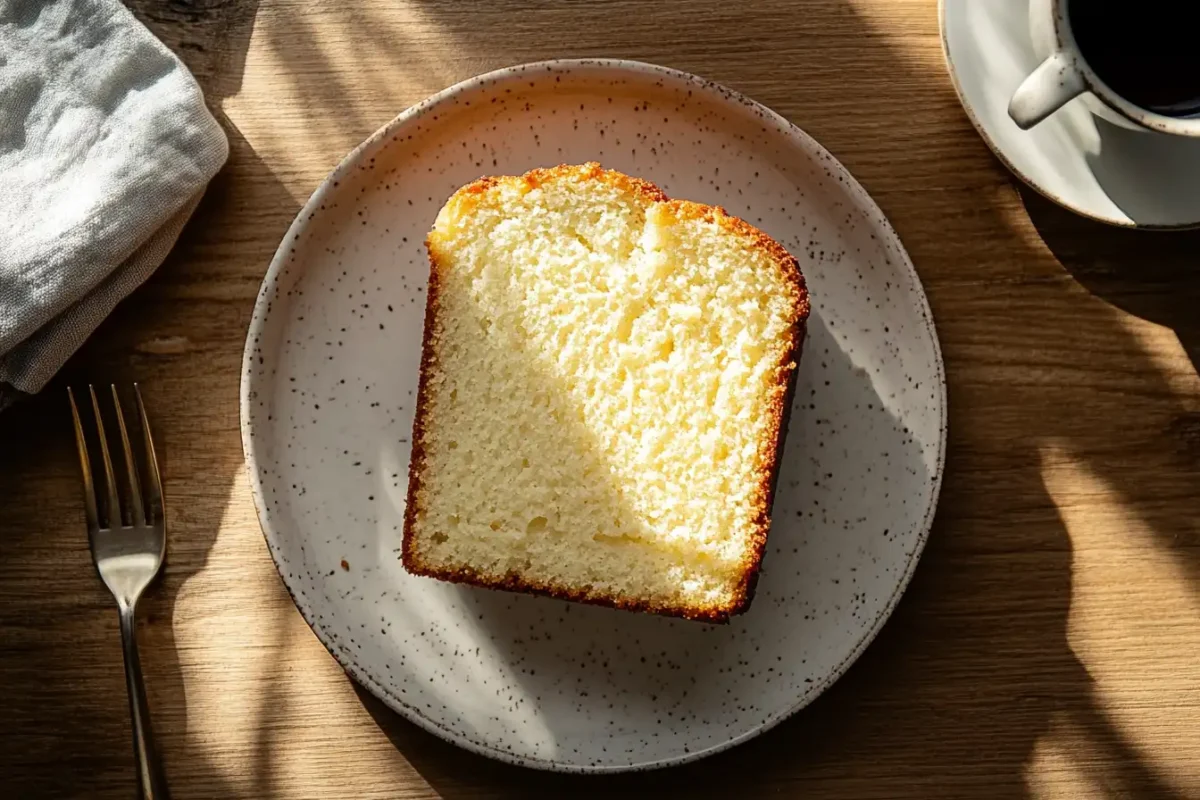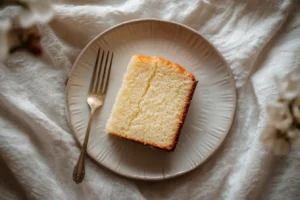Is cake flour or all-purpose better for pound cake? This article explores how each flour affects texture and structure. Discover which flour best suits your baking needs, focusing on achieving optimal results.
The Great Flour Debate: Cake Flour vs. All-Purpose for Pound Cake
Deciding on flour is essential for the perfect pound cake. Indeed, the flour you use impacts the final product. Is cake flour or all-purpose better for pound cake? The answer affects texture. Choosing correctly is a key baking step, undoubtedly. We’ll compare the impact of both types, specifically their protein content and gluten development. Ultimately, the best choice depends on your desired result. So, let’s delve into the details, exploring how each flour affects the outcome.
If you’re experimenting with pound cakes and want to add a chocolate twist, check out the Chocolate Pound Cake Recipe for a delightful variation on this classic dessert.
Understanding Flour: A Baking Foundation
Firstly, understanding the differences is vital. Flour provides structure in baked goods. All-purpose flour is a common type. It has a moderate amount of protein. This protein, when mixed with water, forms gluten. Gluten gives baked goods elasticity and chew. On the other hand, cake flour has a lower protein content. Therefore, it produces less gluten. This results in a softer, more tender crumb. The right choice affects the cake’s overall characteristic, undoubtedly. Let’s further explore how these characteristics differ, in detail.
What is All-Purpose Flour?
All-purpose flour is a baking staple. It is a mixture of both hard and soft wheat. This blend allows for a balance, equally useful in many recipes. Consequently, it is versatile for many baking tasks. However, for pound cake, its protein level is important, particularly. The higher protein develops more gluten. Therefore, it creates a denser crumb. This is not always desirable for pound cake. Specifically, a dense texture can result in a tougher cake. Furthermore, all-purpose flour can absorb more liquid. This might lead to a slightly drier outcome. It is a convenient choice, yet not ideal for all pound cake recipes. Because it can affect the final product so greatly.
Unveiling the Secrets of Cake Flour
Cake flour, in contrast, has a fine texture. It’s milled from soft wheat. This means less protein is present. Consequently, it creates a tender crumb. Its low protein content develops less gluten. Therefore, cakes baked with cake flour are very light. They also have a delicate structure. Indeed, cake flour is perfect for light and airy results, specifically. Additionally, it’s often bleached. Bleaching changes its starch structure. This further contributes to the tender crumb. If you’re aiming for a melt-in-your-mouth texture, cake flour is a strong contender. Ultimately, the difference in protein is what matters most here, chiefly.
Cake Flour or All-Purpose Better for Pound Cake? Examining the Texture
The texture of pound cake is crucial, essentially. It’s where cake flour or all-purpose choices make an impact. All-purpose flour, with its higher protein, creates a denser texture. This results in a cake that’s slightly chewy. However, it can be heavier. In contrast, cake flour’s lower protein develops less gluten. Therefore, the cake is more tender. The crumb is also much finer and lighter. This offers a more delicate eating experience. Choosing cake flour often results in a superior pound cake, in most cases.
The Role of Gluten: A Closer Look
Gluten is a key element in baking, fundamentally. It develops when protein in flour mixes with water. The more protein, the more gluten forms. Therefore, all-purpose flour produces more gluten. This results in a chewier texture. However, less gluten is better for pound cake. Cake flour, with its lower protein, forms less gluten. Accordingly, it leads to a more tender texture. Generally, controlling gluten development is essential for baking success. Because it greatly affects the final result, unquestionably.
How Protein Levels Affect Baking
Flour’s protein content is a critical factor in baking. Cake flour, with its lower protein, creates light, airy textures. All-purpose flour’s higher protein can create denser, chewier results. However, this is not always desirable for pound cake. Understanding these protein differences aids in baking decisions. Moreover, it helps create the ideal texture. Specifically, for pound cake, the goal is typically tender rather than chewy. Therefore, the protein content is a very important consideration, indeed.
Is Cake Flour or All-Purpose Better for Pound Cake? The Structural Impact
Beyond texture, flour also impacts structure. All-purpose flour can make a pound cake quite dense. This can result in a cake that’s sturdy but heavy. In addition, it may not have a delicate crumb. On the other hand, cake flour produces a lighter and more delicate structure. It results in a cake that rises better. The crumb is also more uniform. Consequently, it’s ideal for a tender, evenly textured pound cake. Thus, choosing flour significantly affects the structure, primarily.
Comparing Moisture Retention
Flour also plays a role in moisture retention. All-purpose flour can absorb more liquid. This can sometimes lead to a drier cake. However, cake flour is a better choice in this regard. It holds moisture well. Therefore, a cake made with cake flour will remain moist. Especially, over time. This is a key factor for pound cake. A dry pound cake is not ideal. Therefore, moisture retention is important for optimal results, absolutely.
When To Use All-Purpose Flour in Pound Cake
Despite its tendency towards density, all-purpose flour can still work. Specifically, if you like a chewier cake. Additionally, if the recipe calls for it, that’s fine. However, some recipes adapt all-purpose flour with modifications. Techniques include using less flour. You can also add extra moisture to the batter. Basically, it’s about adapting. This helps mimic cake flour’s effect. Nevertheless, it usually does not achieve the same level of tenderness. So, it’s a matter of taste, ultimately.
Is Cake Flour or All-Purpose Better for Pound Cake? Recipe Adaptations
Adapting your recipe is possible. If you must use all-purpose flour, try these tips. Initially, use a little less flour than the recipe calls for, specifically. Moreover, sift the flour very well. This creates a lighter batter. Furthermore, be sure to mix the batter gently. Over-mixing can increase gluten development. Additionally, add a little extra moisture, like buttermilk. Accordingly, these adjustments can improve the texture of pound cake, to some extent.
Cake Flour or All-Purpose Better for Pound Cake? The Importance of Sifting
Sifting flour is important, indeed. It helps to aerate the flour. Therefore, it prevents lumps. Sifting makes the flour lighter. Thus, it mixes more easily with other ingredients. This helps improve the cake’s texture. Specifically, when using all-purpose flour, sifting is beneficial. It reduces gluten development. It also helps create a finer crumb. So, it’s a simple but important step, undoubtedly.
The Role of Butter and Sugar
Butter and sugar are important ingredients too. They affect texture and moisture, particularly. Specifically, creaming butter and sugar together properly is important. It aerates the batter. Moreover, it creates a light base. This also contributes to a tender crumb. Indeed, these steps are essential. Pay attention to them. They work in tandem with the flour choice. Thus, consider them together, always.
Mixing Methods for Success
Mixing methods matter, significantly. For a tender cake, don’t over mix the batter. Over mixing develops gluten. Therefore, it leads to a tougher cake. Instead, mix until just combined. Also, use a gentle hand. This is especially important with all-purpose flour. It helps to control gluten formation. So, always mix gently. It makes a huge difference in texture, absolutely.
Can You Make Cake Flour Substitutes?
If you don’t have cake flour, there are ways to make substitutes. One common method is using all-purpose flour. For every cup of all-purpose flour, remove two tablespoons. Replace them with two tablespoons of cornstarch. This helps to lower the protein. It creates a result closer to cake flour. Nevertheless, the texture will not be exactly the same. However, it’s a good substitute in a pinch, undoubtedly.
Weighing Flour for Accuracy
Weighing flour is a great option for accuracy. Specifically, using a kitchen scale ensures precise measurements. Cup measurements can vary. This results in different consistencies. Therefore, weighing provides better control. Moreover, it improves consistency. Thus, it’s recommended for baking, generally. Especially, with ingredients like flour, for the best results.
Baking Temperature Considerations
Baking temperature is crucial too. It affects both texture and rise. Specifically, a consistent oven temperature is ideal. Additionally, preheat your oven thoroughly. This prevents uneven baking. Moreover, do not open the oven door while baking. Doing so can cause temperature fluctuations. Ultimately, following these rules helps the pound cake bake perfectly. It ensures the right texture and rise, certainly.
Checking Doneness of the Pound Cake
After baking, checking for doneness is important. A toothpick inserted in the center should come out clean. This indicates that the cake is fully cooked. Additionally, a slight crack on top is typical. It shows the cake has risen well. Therefore, always check carefully before removing the cake from the oven. It ensures a perfectly baked cake, each time.
Cooling Your Pound Cake
Cooling is a key part of the baking process, certainly. Initially, let the cake cool in the pan for a bit. This allows it to set properly. Subsequently, transfer it to a wire rack to cool completely. This prevents the bottom from becoming soggy. Therefore, always cool the cake fully before slicing. Cooling prevents the cake from crumbling when cut, specifically.
Storing Your Pound Cake
Properly storing pound cake is very important, absolutely. It keeps it fresh for longer. Specifically, store it in an airtight container. This keeps it moist. Additionally, you can store it at room temperature for a few days. Or, refrigerate for longer storage. Moreover, consider slicing before storing. Accordingly, this can simplify serving later, if needed.
Is Cake Flour or All-Purpose Better for Pound Cake? Final Recommendation
So, is cake flour or all-purpose better for pound cake? The answer leans towards cake flour, mostly. It consistently delivers a more tender crumb. It also provides a lighter texture. However, all-purpose flour can work. Adjustments must be made in the recipe. Therefore, if you want a superior pound cake, cake flour is the best choice. It is the essential for a delicate texture, generally.
The Science of Flour: A Deeper Dive
The science behind flour’s behavior is complex. Specifically, the starch granules in flour absorb liquid during baking. This causes them to swell and contribute to the cake’s structure. Additionally, gluten proteins interact to create a network of structure. However, different flours have different properties. Therefore, they have varying interactions. Moreover, the amount of gluten formed is key. Accordingly, this dictates the texture and final result. Ultimately, understanding this science can help you bake better pound cakes, always.
Troubleshooting Common Pound Cake Issues
Baking doesn’t always go as planned. For example, if your pound cake is too dense, check the flour. You may have used too much all-purpose flour. Another common issue is a dry pound cake. Therefore, you may have used too much flour or baked it for too long. Also, if your cake is too crumbly, there could be too much fat or not enough gluten development. Indeed, troubleshooting baking problems can be complex. However, knowing the causes allows for improvement, undoubtedly.
The Impact of Different Sugars
Sugar isn’t just for sweetness. It affects moisture and texture. For instance, granulated sugar adds crispness. However, brown sugar makes a cake more moist. Specifically, you can adjust the sugar types. Moreover, changing these proportions can change the cake. Consequently, different sugars can create a diverse texture. It’s worth exploring different sugar combinations. This creates unique pound cake experiences.
The Influence of Fats
Fats are key for tenderness. Primarily, butter provides a rich flavor. Additionally, it also contributes to a tender crumb. However, using too much fat can make a cake greasy. Moreover, using less fat can make it dry. Therefore, finding the right balance is key. Using the right amount of fat is essential for a well-textured cake.
Flavor Enhancements for Pound Cake
Pound cake is versatile. Accordingly, you can enhance its flavor. For example, use vanilla extract for flavor depth. Also, you can use citrus zest for brightness. Furthermore, you can try different extracts. Similarly, spices can add a touch of warmth. Experimenting with different flavors is key to finding your favorite.
The History of Pound Cake
Pound cake has a rich history. Initially, it got its name from the pound of each ingredient. Specifically, a pound of flour, butter, sugar, and eggs. Over time, the recipes have evolved. However, the basic concept remains the same. It is a delicious, simple cake. The simplicity is part of its charm. It’s always been a favorite, undoubtedly.
Variations of Pound Cake
There are many variations of pound cake. For example, some have chocolate or lemon. Additionally, some use different spices. Moreover, there are versions with sour cream or cream cheese. The variations are endless. It’s a great canvas for culinary creativity. You can create a pound cake that suits your taste.
Serving Ideas for Pound Cake
Pound cake can be served in many ways. Specifically, it’s delicious with fresh berries and cream. Also, it’s great with a scoop of ice cream. Additionally, a glaze or sauce can enhance its flavor. It’s versatile enough to be served at any occasion. It can be simple or elegant, as you wish.
Frequently Asked Questions (FAQs)
What does cake flour do in baking?
Cake flour, with its low protein content, creates a light and tender texture in baked goods. Specifically, it’s perfect for cakes where a soft, delicate crumb is desired. The low protein inhibits gluten formation. Consequently, the cake has a very soft and fine texture, undeniably.
Can I use all-purpose flour for cake?
Yes, you can use all-purpose flour for cake, but it will often result in a denser and slightly chewier texture compared to using cake flour. It’s possible, but not always ideal if you want a very tender cake. You can also adjust recipes by decreasing the flour amount and adding extra moisture if needed.
What’s the difference between all-purpose and cake flour?
The main difference lies in the protein content, primarily. All-purpose flour has a moderate amount, while cake flour has a significantly lower amount. This variance in protein directly affects gluten development. Hence, it profoundly influences the final texture of your baked goods. The protein content determines the gluten level.
Is cake flour the same as self-rising flour?
No, cake flour and self-rising flour are not the same. Cake flour is a low-protein flour. Self-rising flour includes baking powder and salt in addition to the flour. Therefore, they’re used differently in baking and cannot be interchanged. Consequently, they serve distinct purposes in recipes.
How does flour affect the texture of pound cake?
The type of flour drastically changes the texture of the cake. Cake flour, with its low protein, creates less gluten, leading to a tender crumb. All-purpose flour, with higher protein, creates more gluten, resulting in a denser, chewier texture, comparatively. The key is the amount of gluten development.
Can I mix cake flour and all-purpose flour?
Yes, mixing cake flour and all-purpose flour is a method to adjust the texture of a cake. This mixture produces a middle ground between the tender crumb of cake flour and the sturdy structure of all-purpose flour. Therefore, this method allows for some control over the final result.
Conclusion: Mastering the Art of Pound Cake
In conclusion, flour choice greatly affects pound cake texture, certainly. Cake flour produces the best results for tenderness. However, all-purpose flour is versatile, and you can adapt. Understanding these flour differences is key. Therefore, you can create perfect pound cake. Remember to consider all these factors in your baking. Ultimately, practice and your taste will determine the best result, unquestionably.
For even more tips on creating soft and delicious pound cakes, you might want to explore How Do You Keep Pound Cake Moist?, where you’ll find techniques to maintain texture and flavor.



